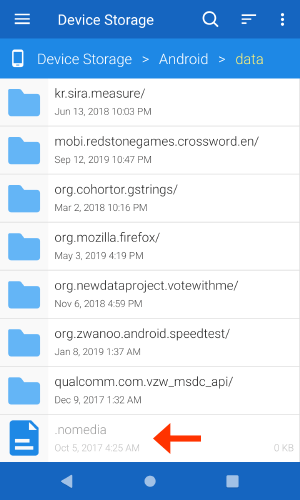What is a .NOMEDIA file on my Android device?
When browsing files on your Android device, you may encounter an unnamed file with a .nomedia file extension. The NOMEDIA file serves as a "do not index" label for the folder. It prevents apps like photo managers and video players from scanning and indexing the folder's contents.

NOMEDIA files are used for several reasons:
- To boost app performance by excluding folders with a large number of videos, images, or audio files that do not need to be indexed. For example, you could exclude a folder with an archive of several thousand images to decrease the loading time of a photo gallery app.
- To hide sensitive media files from being discovered and loaded by multimedia apps. For example, you could add a NOMEDIA file to a folder containing private photos.
- To prevent images from third-party apps, including advertising banners, from being indexed.
Where are .nomedia files stored?
NOMEDIA files are typically found in multimedia folders or external storage cards connected to an Android smartphone or tablet. In rare cases, they may show up on a PC or Mac that has been synced with an Android device.
Can I create a .nomedia file?
Yes, you can create a NOMEDIA file and place it in a folder you don't want indexed. Simply create an empty text file, delete the filename, and rename the file extension to ".nomedia". Instead of creating a new file, you can also copy an existing NOMEDIA file from another folder and paste it into the folder you do not want indexed.
NOTE: Changing the filename of a text file to ".nomedia" may hide the file since files starting with a dot are hidden by default on Android devices. You can use a program like File Viewer for Android to view NOMEDIA and other hidden files.
Can I delete a .nomedia file?
Yes, NOMEDIA files can be deleted. They are empty files that do not store any important content. However, once a NOMEDIA file is deleted, the multimedia files stored in the corresponding folder will be scanned and indexed by apps.